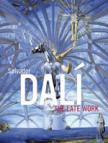Eccentric Showman
It is impossible to be a Catholic in the Western world without knowing the art of Spanish artist Salvador Dalí (1904-1989). Walk into any Catholic institution—school, rectory, convent or chancery—and you are likely to find a reproduction of one of his religious paintings, like the “Christ of St. John of the Cross,” the “Corpus Hypercubicus” (Mary kneeling before the crucified Jesus) or “The Sacrament of the Last Supper.” Indeed, the original first version (1949) of the equally beloved “The Madonna of Port Lligat” is in the collection of a Catholic university, Marquette’s Haggerty Museum of Art in Milwaukee. All of these brilliantly executed and stirringly pious canvases long ago reached their secure status as virtually universal icons within the Catholic world.
Dalí’s patently “Catholic” paintings were all done in the second half of the artist’s career, which began in 1939, a decisive turning point in Dalí’s artistic development and persona. In that year the artist publicly rejected the Surrealist movement that had made him world famous. (Nonetheless, Dalí’s perhaps most famous and critically acclaimed painting remains the quintessentially surrealist “Persistence of Memory” [1931]—melting clocks on a desolate landscape—in New York’s Museum of Modern Art.) Publicly supporting Generalissimo Franco’s fascist regime and converting to Roman Catholicism (opportunistically, some suspected), Dalí declared himself now a “classicist” in art—that is, one who was, ostensibly, devoted to the principles of and sought to emulate the achievements of the Old Master painters, especially of the Renaissance. All of this seemingly reactionary ideology, together with Dalí’s shameless and ever more eccentric showmanship, did not sit well with the artistic establishment, which was thoroughly modernist and avant-garde and disdainful of artists who made vulgar commercial display of themselves and their art work.
The result, as far as Dalí’s critical fortune is concerned, has been a general discounting of the works of these many decades of production, with a tendency simply to ignore them in official surveys—textbooks or exhibitions—of modern art. Instead, at this point, enough time has passed since Dalí’s death, the political passions of the World War II generation have cooled, and artistic attitudes have changed sufficiently for there to be a re-assessment of the late but supposedly not great Dalí.
This brings us to the volume under review, a handsome, generously illustrated catalog of a well-conceived, comprehensive, multimedia exhibition at Atlanta’s High Museum of Art (until Jan. 9, 2011) that focuses specifically on the Dalí of the long second half of his career. The volume and the exhibition include, but of course are not restricted to, Dalí’s “Catholic” works, enlightening them and all the works in question by placing them in the well-researched, specific personal and historical context in which they were produced. The exhibition and companion volume explicitly seek to undertake a re-evaluation of the late Dalí and thus, by implication, draw a new appreciation for what he was then striving to express in his art. But they do so with complete intellectual honesty, making no attempt to hide or explain away that which might be deemed unseemly, bizarre, contradictory, inauthentic or mediocre of this second Dalí. All of this is accomplished in the long, well-documented introductory essay by Elliott King (“Dalí After 1940: From Surreal Classicism to Sublime Surrealism”) and a shorter but equally valuable one by William Jeffett (“Publicity, Propaganda, Provocation: Dalí’s Mustache in the Press”).
Whether or not the late Dalí will also be rehabilitated, and not just re-evaluated, in the eyes of the larger and more critical public as a result of this exhibition and catalog remains to be seen. What they do show is that the discontinuity between the first and second periods of Dalí’s career is in reality not as great as the artist’s own statements would lead one to expect. (For example, just shortly after painting all the aforementioned “Catholic” canvases, he produced his shockingly erotic and still surreal “Young Virgin Auto-Sodomized by Her Own Chastity” [1954]).
They show, furthermore, that, whether or not one likes his new post-1939 ideology or subject matter, Dalí’s marvelously fertile imagination, studied pursuit of visual experimentation and extraordinary technical skills remained unabated. This is why even the late Dalí influenced the subsequent development of contemporary art. It is also difficult not to admire the pains—both physical and mathematical—that Dalí continued to take to achieve the sometimes stunning effects of his compositions. The extreme foreshortening of his “Christ of St. John of the Cross” (1951), for instance, was achieved by drawing a live model seen through a glass floor upon which the artist stood at his canvas.
The volume and exhibition also show that, again, politics and subject matter aside, credit must be given to Dalí for attempting to do what every serious artist must do: make a sincere effort at truly understanding and then accurately reflecting in the medium of art the most authentic reality of his or her age, especially its latest and most attitude-changing, spirit-shaking developments and discoveries—scientific, philosophical, political, etc. In taking seriously the revolutionary new insights of modern psychology and physics and allowing his artistic style to be transformed in the process, Dalí—both before and after 1939—was true to his calling as an artist in the highest sense of that term.
An acute observer of his times, Dalí, for all his self-proclaimed “classicism” and (often bizarre) “Catho-licism,” well understood there was no going back to understanding and hence depicting the world as before, not once Freud had definitively disabused us of simplistic notions of the human psyche, not once the atom bomb had been dropped, and not once modern physics had exposed the utter relativism of what we once considered the hard, fixed material universe. Moreover, and finally, Dalí, for all his deplorably commercial showmanship, understood that art must viscerally provoke and gratify the senses, and there is no denying that even the latest Dalí succeeds in accomplishing this.
This article also appeared in print, under the headline “Eccentric Showman,” in the November 22, 2010, issue.








